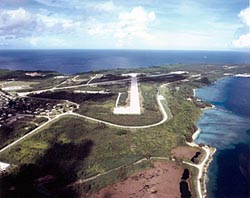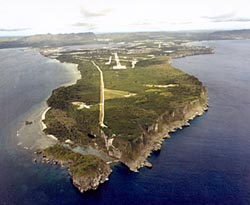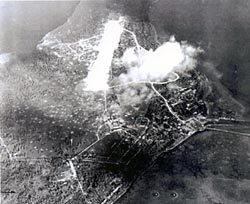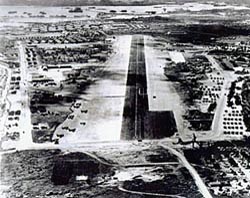
Orote Field played a significant role in the World War II battles between the Japanese and Americans on Guam. However, a pioneering effort in military aviation in the western Pacific began even earlier when a U.S. Marine Squadron arrived in Guam on March 17, 1921, including 10 pilots and 90 enlisted men. The Marine unit constructed an air station near the water at Sumay village, including a hangar for their amphibious aircraft. In 1926, a new administration office was constructed which housed the squadron offices, sick bay, dental office, aerological office and guardhouse. In early 1927, the squadron was sent to China to protect American lives during the Chinese civil war, and became stationed at Olongapo, in the Philippines, which they used as a base to patrol the Chinese coast. Only a handful of men remained here until September 23, 1928, when Patrol Squadron 3-M, consisting of 85 enlisted men and 4 to 6 officers, was assigned to Guam. But shortly thereafter, the naval air station was closed on February 24, 1931, as a cost-saving measure.

When the Japanese attacked Guam on December 8, 1941, they did not bomb the abandoned naval air station. Guam was captured and occupied by the Japanese from December 13, 1941, to July 9, 1944. During that time, the Japanese military government constructed Orote Field, a land-based airfield, using Korean and Guamanian labor. On February 23, 1944, American carrier based airplanes attacked the field, and other American raids soon followed. During the Battle of the Philippine Sea the field was used by the Japanese carrier-based airplanes to refuel and rearm. The Japanese airplanes based at Orote Field were also used to attack the American fleet. As of June 1, 1944, Japanese air strength on Guam consisted of 100 Zeros and 10 Gekkos (night fighters) at Airfield #1 and 60 Ginga (bombers) at Airfield #2. It is not clear from the source material, which of these two airfields was Orote Field. However, American raids on June 19, 1944 destroyed the landing fields, the aircraft on the ground and such aircraft that managed to take off. American pilots reported extremely intense antiaircraft fire around Orote Field. Fifteen Japanese airplanes crashed while attempting to land on Orote Field on June 19, 1944. On June 20, 1944, numerous actions occurred in the immediate vicinity of Orote Field between American carrier airplanes and Japanese aircraft seeking refuge at Orote Field after flying from their carriers, or Japanese airplanes needing to refuel and rearm to attack American carriers. Numerous dogfights took place in the air above Orote Field and numerous strikes by American airplanes destroyed Japanese facilities and airplanes on the ground. This was significant because it denied the Japanese the use of a crucial airfield in the battle.

The Japanese assigned the defense of Orote Peninsula to the 54th Independent Guard Unit under command of Air Group Commander Asaichi Tamai. After the invasion on July 21, 1944, the 1st Provincial Marine Brigade under command of Lt. General Lemuel C. Shepherd fought its way through the village of Agat to the base of Orote Peninsula. Here the Japanese had constructed an elaborate interlocking system of pillboxes, strongpoints and trenches. Regiments of the 1st Provisional Marine Brigade, the 4th and 22nd, fought their way through the area. Shortly before midnight on July 26, 1944, the Japanese trapped on the peninsula staged a suicide attack and were completely wiped out. The advancing Marines still met heavy Japanese resistance in the vicinity of the airfield, where the Japanese fought from caves and coconut bunkers. The peninsula was declared secure on July 29, 1944. It is estimated that the Japanese lost more than 3,000 men defending Orote Peninsula.

Orote Field was used by Marine air power for close combat support missions during the liberation of Guam. This was accomplished by Marine Air Group (MAG)-21 flying Corsairs from Orote Field. By mid-November 1944, MAG-21, now commanded by Colonel Edward B. Carney, was an oversized group, having 12 squadrons based at Orote Field, 529 officers, 3,778 enlisted men and 204 aircraft. MAG-21 was shifted to Agana airfield in 1945, as air operations at Orote Field had always been hampered by adverse crosswinds. The field was next used as a Navy casualty unit for the repair of damaged aircraft. Orote Field was finally closed to all but emergency landings in 1946. Today, the cross-runway is used for C-130 touch-and-go flight training, and for helio-ops by Navy Seals. Much of the time the airfield is off-limits.
Visit the National Park Service Travel American Aviation to learn more about Aviation related Historic Sites.
Last updated: August 29, 2017
